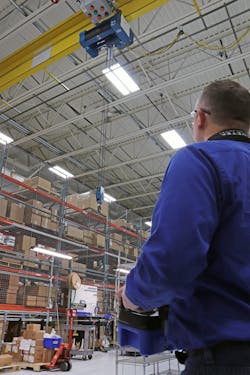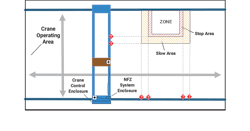Using Automation Technology to Improve Facility Safety
Manufacturers are up against a variety of challenges in today’s evolving world. Keeping safety top of mind and creating processes to integrate safety into their operations is of utmost importance.
In a time when everyone is looking for ways to socially distance and monitor production floor activities, promoting and improving safety, while maintaining productivity, can be difficult.
Automation technology can help. Automated systems can reduce the risk of accidents, as well as help avoid and prevent work injuries, resulting in a safer workplace for everyone. By making the workplace safer, uptime and productivity will also increase.
According to the Bureau of Labor Statistics, from 2011 to 2017, the Census of Fatal Occupational Injuries (CFOI) reported 297 total crane-related deaths, an average of 42 per year over this seven-year period. Fatal injuries involving cranes and being struck by an object or equipment accounted for 19 of these fatalities. These situations can often be attributed to swinging or snagged loads.
If you have ever experienced a swinging load, you know they can be extremely dangerous for operators. The problem is these incidents may not get reported as expected, limiting the ability to track leading indicators and put preventative measures in place. Fully eliminating these risks may not be possible, so the next most effective way to mitigate them is to design and install a system that will prevent a swinging load.
One solution is to incorporate an intelligent off-center pick system. This kind of system alerts operators with a visible and audible warning before a dangerous load misalignment or snag condition occurs. Using sensors and a status control enclosure, the system activates directional lights and a programmable warning horn when it detects a side pull or off-center pick. An off-center pick system will then assist operators, through manual or automatic adjustment, to center the bridge and trolley over the load before it is hoisted. As an added layer of protection, some of these systems can also detect snagged conditions that occur along the travel path, or when an operator moves hooks, slings and rigging to the next lift, and stops all motions (see photo below).
Key to communication, off-center pick systems can display and log data related to misalignments and snag events. This information can be used to adjust processes and equipment locations and identify needs for operator training. Data can be accessed through an intuitive user interface via a smartphone, tablet, or PC. Systems with wireless access make it safe to monitor and configure the system from any location.
Another type of automation technology that can help improve safety is a no-fly zone (NFZ) system. No-fly zone systems allow you to designate zones where the hoist and load below the overhead crane will not enter. These are protected areas where normal crane operation is limited or entirely restricted. Using an NFZ system, you can program the crane to slow down or stop, using motion control products such as variable frequency drives, radio remote controls, limit switches, and sensors. Implementing these systems—ranging from simple configurations to the more complex—can help limit the risk of collisions, increase safety for equipment and personnel, and improve facility throughput (see Figure 1). NFZ systems can utilize laser positioning sensors installed on bridge and trolley motions that interface with a controller for functional customization. Providing flexibility for your application, these systems can be configured to your exact requirements and can be modified from any personal electronic device as changing process, plant and crane conditions require. Automation experts can help companies perform detailed risk analyses for lifting and help specify safety zones on their production floors where lifting operations are a concern.
While these products are an option to remotely monitor operations, they do not serve as a replacement for good training that will qualify operators to safely and properly use equipment. Automation technology is an additional resource that can help improve your overall safety to prevent high-risk and unintentional movement and give you remote visibility to identify where issues may be occurring.
Implementing Safety Measures in Your Facility
Detecting a problem is one thing but preventing it from happening in the first place is another. To start the process of making your facility safer, the first step is evaluating your data and asking these questions: Why is safety important? How can you improve your operational safety? What is the biggest safety issue you are facing? By talking through the processes, and asking these questions, you will be able to identify the right solution to improve safety in your facility.
Some people face these problems daily. So often, in fact, that they are used to them and not aware of their potentially detrimental effects and safety impact. We recommend a contextual inquiry and an on-site assessment to observe and question personnel in these environments with the overall goal to improve facility safety.
The safer you operate, the more profitable you will be. Let’s repeat that: The safer you operate, the more profitable you will be. Do not compromise safety to get more product out the door—that is the wrong approach. Address safety first, which will improve your uptime and productivity. By building safety into your operations, you can prevent accidents that cause downtime while increasing throughput. Ultimately, you should address safety first because employee safety should be the number one priority, so people can go home the same way they came into work. When you address safety first, everything else will fall into place.
Erika Strand is global EHS manager and Peter Stipan is global director, Automation Division, with Columbus McKinnon Corp., a manufacturer of lifting and motion control solutions.
About the Author
Erika Strand
Erika Strand is global EHS manager with Columbus McKinnon Corp., a manufacturer of lifting and motion control solutions.


